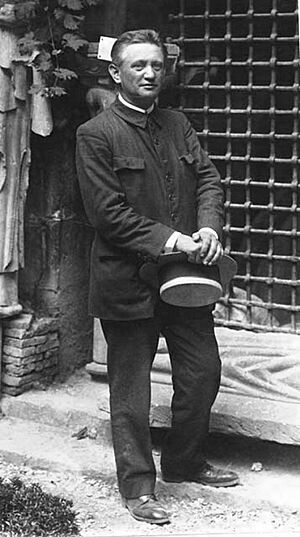Hugo Obermaier facts for kids
Hugo Obermaier (born January 29, 1877, in Regensburg, Germany – died November 12, 1946, in Fribourg, Switzerland) was a very important Spanish-German expert on ancient history and human development. He taught at many universities in Europe. Even though he was born in Germany, he became a Spanish citizen in 1924. He is famous for his studies on how people spread across Europe during the Ice Age. He also did important work on the amazing cave art found in northern Spain. He was brave and refused to let his science be used for harmful nationalistic or racist ideas in Germany during the 1930s.
Hugo Obermaier's Career
Hugo Obermaier spent his childhood and early student years in Regensburg. In 1900, he became a diocesan priest, which is a type of Catholic clergyman. From 1901 to 1904, he studied many subjects in Vienna. These included Prehistoric archaeology (the study of ancient human history), physical geography, geology (study of Earth's structure), palaeontology (study of fossils), ethnology (study of cultures), and human anatomy.
Some of his most important teachers were Albrecht Penck, Josef Szombathy, and Moritz Hoernes. In 1904, he earned his doctorate degree. This is a very high academic degree, for his work on The Diffusion of Humankind during the Ice Age in Middle Europe. Four years later, he became qualified as a lecturer, which means he could teach at a university. In 1909, he became an unsalaried university lecturer in Vienna.
In 1911, he became a professor at the new Institute of Human Palaeontology in Paris. He worked there until First World War began. During this time, he worked with other scientists like Wernert and Henri Breuil. They explored caves like El Castillo and the Cueva de La Pasiega in Cantabria, Spain.
While in Spain in 1914, he decided to work at the National Museum of Natural Sciences in Madrid. Later, in 1922, he became a professor at the Complutense University in Madrid. He also dug at the famous Cave of Altamira in 1924-1925. He worked with Henri Breuil to publish their findings about this cave in 1935. He also studied ancient rock engravings in south Oran with Frobenius in 1925.
Hugo Obermaier chose not to return to Germany in 1933. This was due to scientific, personal, and political reasons. He refused an invitation to take a special teaching position in Berlin. After the Spanish Civil War started, he left Spain in 1939. He then became a professor in Fribourg, Switzerland. Hugo Obermaier passed away in Fribourg after a long illness.
Hugo Obermaier Society
Hugo Obermaier's main scientific work was in studying the Old Stone Age, also known as the Palaeolithic period. He was one of the first to see this as a serious area for scientific research.
To honor his memory and to help continue research into the Ice Age and Stone Age, a group was formed. On June 23, 1951, archaeologists, geologists, palaeontologists, and anthropologists created a society. It was led by Lothar Zotz. In 1956, the group officially became the "Hugo Obermaier Society for Research into the Ice Age and the Stone Age." This society helps scientists learn more about these ancient times.
See also
 In Spanish: Hugo Obermaier para niños
In Spanish: Hugo Obermaier para niños
- List of Roman Catholic cleric–scientists


